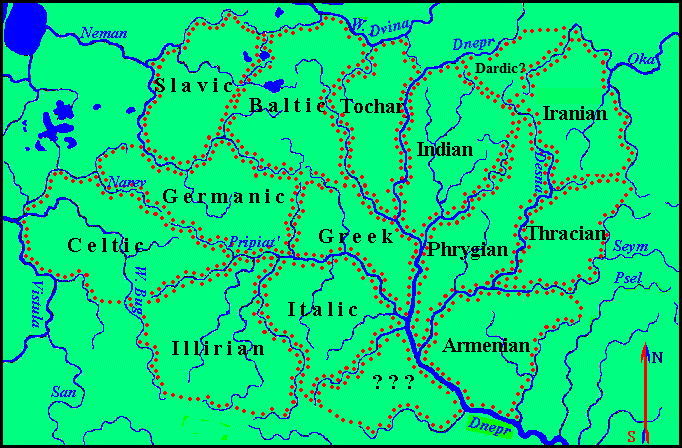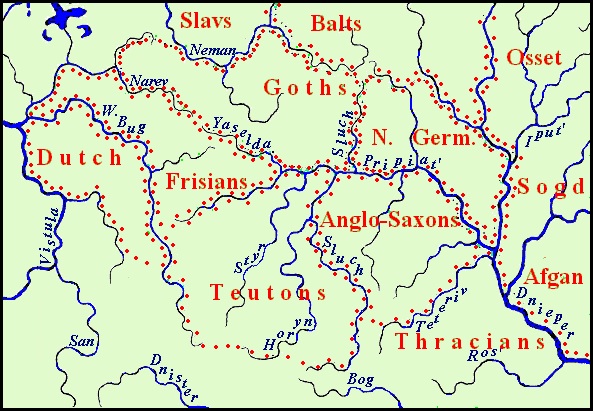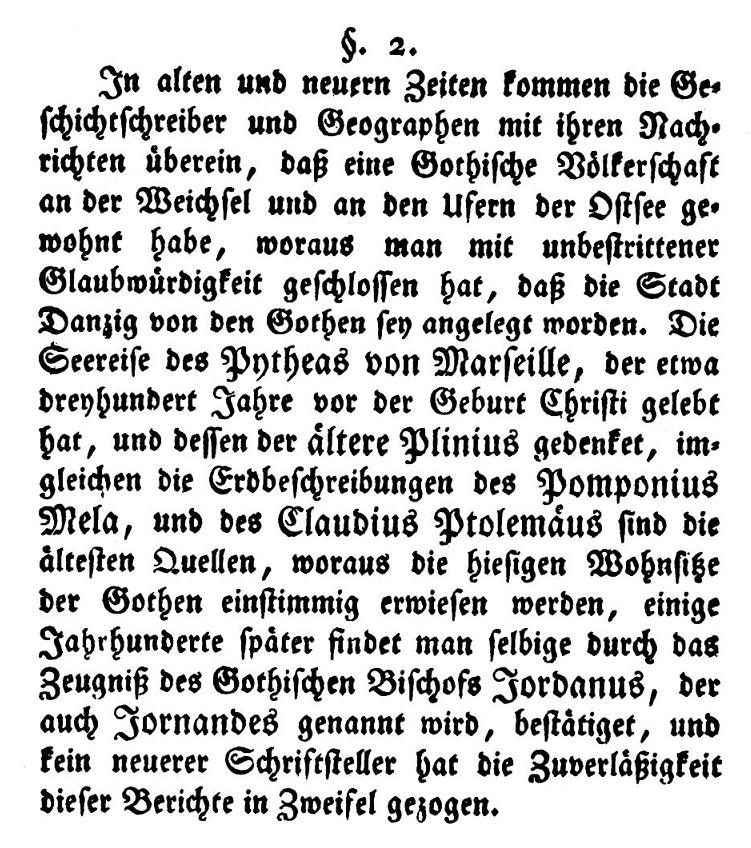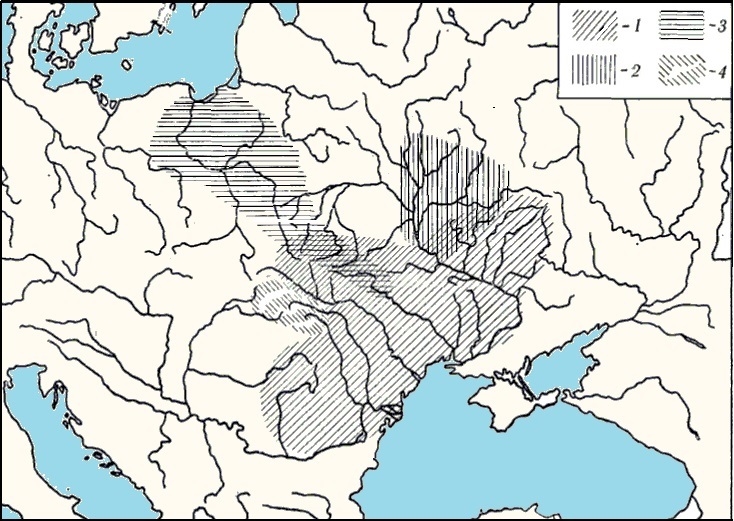An Ancient History of the Goths
Stetsyuk Valentyn, Tverdokhlib Oleksandr
The Urheimat (ancestral home) of the Germanic peoples on the whole Indo-European space, which was determined using the graphic-analytical method, was located in the area between the Neman, Narev, Yaselda Rivers, and its eastern boundary was the Sluch River, the left tributary (lt) of the Pripyat River (see Fig. 1)

Fig. 1. The habitats of the ancient Indo-Europeans
After First Great Migration when most Indo-European tribes began the migration to new habitats, the Ancient Germanic people still remained near their Urheimat though considerably expanded their settlement territory.
The resettlement resulted in large changes in the paternal Germanic language. It is supposed that the common language for all Germanic people existed till the 3rd cent. AD and it was split after the migration of Germanic tribes into Central and North Europe [SCHMIDT WILHELM. 1976: 44]. But the analysis of Germanic languages by the graphic-analytical method brings us to different conclusions.
For the analysis, the first such modern Germanic languages were taken: German, English, Dutch, Swedish, as well as the dead Gothic. Later, the Swedish language material was supplemented with vocabulary from other North Germanic languages, and Frisian was also involved in the study. Based on the analysis of the etymological dictionaries of the German, Old English, Gothic, and Dutch languages [А. KLUGE FRIEDRICH, SEEBOLD ELMAR, 1989; VEEN P.A.F. van, SIJS NICOLINE van der, 1989; HOLTHAUSEN F., 1934; HOLTHAUSEN F. 1974] and bilingual dictionaries of other Germanic, mainly North Germanic languages the Table-dictionary of the Germanic languages was compiled and then used for necessary calculating. This Table-dictionary is among others filed on Etymological Table Database). The list of Germanic phono-semantic sets consisted of 2628 units. 1424 of them were admitted to be common Germanic words and the rest were systematized according to matches. Then the number of mutual words in the individual language pairs was calculated and the result is presented in the table below.
Table. Number of mutual words in pairs of Germanic languages
| Languages | German | English | Dutch | Norse | Gothic | Frisian |
| German | 884 | |||||
| English | 601 | 858 | ||||
| Dutch | 503 | 357 | 632 | |||
| Norse | 412 | 468 | 226 | 651 | ||
| Gothic | 228 | 205 | 132 | 166 | 305 | |
| Frisian | 248 | 237 | 245 | 128 | 82 | 329 |
Using these data, the model of the relation of the Germanic languages was built quite easily (see Fig. 2). The distances between language areas in the diagram are inversely proportional to the number of common words in a pair of languages.
Fig. 2. Graphic model of Germanic languages relationships.
After repeated additions to the Table-dictionary, the kinship scheme has not changed. The placement of English, German, Dutch, and North Germanic on the diagram has always been the same, but a reliable placement of Gothic on it has failed due to insufficient data. The inclusion of the Frisian language in the scheme did not significantly help to resolve the situation.
Since we have only four reliable nodes of the graph, it is very difficult to find a proper location for the model on the map – a variety of locations are possible. A found position will be more veritable if it will be confirmed by other facts. Let us admit such location of the model that the area of Anglo-Saxons lies upon the Urheimat of Italics between the Teterev, Pripyat’ and Sluch (rt of the Pripyat') Rivers. In this case, the area of the ancestries of modern-day Germans (let us name them for convenience Teutons) can be located on the ethno-producing area between the Sluch, West Bug and Pripyat’ Rivers. The ethno-producing area on both sides of the West Bug is suitable to the ancestors of the Dutch (let us name them for convenience Franks). Accordingly, Norsemen had to populate the ethno-producing area between the Pripyat, Dnieper, and Berezina Rivers where the Greek language was formed earlier. This option has been already considered for a long time [STETSYUK VALENTYN. 1998: 45].
The placement of the Norse paternal language area in the same place as the Greek language is confirmed by the presence of a Greek substratum in modern North Germanic languages. As one example of many, such fact can be cited. Ic. hrønn "wave" corresponds to Greek κρηνη "a well, source". Other examples of possible Greek-North Germanic substrates are given in the article Germanic Tribes in Eastern Europe at the Bronze Age. This choice confirms the location of the paternal areas of other Germanic languages.
Agreeing with this arrangement, we see that for the Gothic and Frisian, there was only one free area between the upper Pripyat and the Neman, from the Yaselda to the Sluch River. Locating here the Urheimat of the Goths, Vandals, and Burgundians is in discrepancy to an insufficient number of common words between the Dutch and the Gothic language. This makes us believe that these old Germanic tribes could not be the neighbors of the ancestors of the Franks. Between their areas had to be located a tribe of another language. Perhaps it was the ancestors of the Frisians. The number of common words between the Frisian and other Germanic languages does not contradict this hypothesis. In this situation, the problem might be solved so that the Franks occupied territory not on both sides of the Western Bug, but only of its left bank and the right bank should have been settled by the Frisians. Localization of the ancestral home of the Goths on the territory of Belarus is confirmed by the Lithuanian name of Belarusians Gudai, that is Goths (VASMER M. 1964: 400). Thus, one can think that the Goths inhabited both banks of the Shara River, the left tributary of the Niemen River, i.e. where was the common Urheimat of all Germanic people. The name of this river should be considered as the Paleo-European substrate, which traces can be found in some Germanic languages, cf. Eng. shore, Ger. Schaar "area of the sea, where you can wade". The common Germanic territory could be presented on the map in Fig. 3.

Map 8. Germanic tribes in II mill BC.
The location of the ancestral home of the Goths can be confirmed by local place names of Gothic origin. When their deciphering F. Holthausen's Gothic Dictionary and partly Dictionary of the Icelandic Language as the closest to the Gothic was used. The following are examples of possible place names in Belarus:
Abrova, a village in Ivatsevich district of Brest Region – Goth. *abr-s "strong, stormy".
Alba, a village in Brest Region, Belarus – Goth. *alb-s "a demon".
Bastyn', a village in Lunenets district of Brest Region – the all modern Germanic languages have the word bast "bast, the inner bark of the lime-tree" (Old Norse, Dt. bast, OE. bæst, Ger. Bast). Undoubtedly, this word was present in the Gothic language, but not preserved in written sources referring to specific meaning.
Great Eysmonty, a village in Berestovitse district of Grodno Region – Goth. eis "ice", munþ "mouth".
Hnevenshchina, a village in the Grodno district of Grodo Region – Goth. hneiwan "incline, tilt".
Indura, a village in the Grodno district of the Grodno Region – Goth. in daurō "at the gate".
Odelsk (Adel'sk), an agro town located in Grodno district in Grodno Region – Goth. ōþal "inheritance".
Rumliovo, a forest park in the city of Grodno – Goth. rūm "room, space", lēw "a case".
Trabovychy, a village in Lakhovychy districkt of Brest Region – Goth. *draibjan "to drive".
Vangi, a village в Grodno Region, Belarus – Old Norse vang-r "a garden, green home-field".
Velikie Eysmonty, a village in the Byerastavitsa district of Grodno Region – Gothh. eis "ice", munþ "mouth".
Zelva, the center of district in Grodno Region – Goth. silba, Old Fr. selva "self".
The name of the Shara River, whose banks were by the Goths populated, should be considered as the Paleo-European substrate, which traces can be found in some Germanic languages, cf. Eng. shore, Ger. Schaar "area of the sea, where you can wade".
There are on the Urheimat of the Goths a few place names, which could be deciphered by other Germanic languages (Gresk, Narev, Rekliovtsy), the Gothic language has or maybe had similar words, therefore it is difficult to judge their origin. The place name Huta is the most frequently noted. However, the Gothic language did not have a word similar to OS hutta, Ger Hütte "hut". One can only assume that such a word existed in it, therefore the place names Huta are nevertheless marked in the ancestral home of the Goths.
If traces of the Goths remain in the place toponymy on their ancestral home, then all the more Gothic place names must be preserved in places of their later residence. Clearly, the search began in neighboring areas, that is, in eastern Poland, and quickly succeeded. Gothic place names formed a chain that led to the city of Gdańsk (Danzig):
Kundzin, a village in the administrative district of Gmina Sokółka, within Sokółka County, Podlaskie Voivodeship – Goth. kunþi "relationship, home".
Chilmony, a village in the administrative district of Gmina Nowy Dwór, within Sokółka County, Podlaskie Voivodeship – Goth. hilm "helmet".
Fasty, a village in the administrative district of Gmina Dobrzyniewo Duże, within Białystok County, Podlaskie Voivodeship – Goth. fastan "hold, guard".
Sajno, lakes in Augustów County of Podlaskie Voivodeship and in Pisz County of Warmian-Masurian Voivodeship, – Goth. sainjan "to tarry, hesitate".
Ełk (previous Łek), a town in Warmian-Masurian Voivodeship – Goth. leik "bode".
Ukta, a village in the administrative district of Gmina Ruciane-Nida, within Pisz County, Warmian-Masurian Voivodeship – Goth. ūhtwō "dawn".
Wałdyki, a village in the administrative district of Gmina Lubawa, within Iława County, Warmian-Masurian Voivodeship – Goth. waldan "prevail, govern".
Markowo, villages in Gmina Dubeninki, within Gołdap County and Gmina Morąg, within Ostróda County Warmian-Masurian Voivodeship – Goth. marka "sigh", "border'.
Gruta, a village in Grudziądz County, Kuyavian-Pomeranian Voivodeship – Goth. grūts "grain".
Wandowo, a village in Kwidzyn County in Pomeranian Voivodeship – Goth. wandjan "tp turn".
Kaldowo, a village in the administrative district of Gmina Malbork, within Malbork County, Pomeranian Voivodeship – Goth. kald-s "cold".
Decoding the name of the city of Danzig is not easy, but it was found evidence that the city was founded by the Goths (see the image below)
Fig. 4. The text from the book of Daniel Gralath
The image is a copy of the page from the book of Daniel Gralath "The Try of a Story of Danzig on reliable sources and Manuscripts" (GRALATH DANIEL, 1789: 4). The copy is made out of a book from the Library of Chicago University, posted on the Internet. Translation of the text from German:
As in old and in new times, historians and geographers are unanimous in their reports, concluding that the Gothic nation dwelled along the Vistula River and on the banks of the Baltic Sea, which one can conclude with unquestionable certainty that the city of Danzig was founded by the Goths. The voyage of Pytheas from Marseilles, who lived three centuries before the birth of Christ, and who is mentioned by Pliny the Elder, and also geographies of Pomponius Mela and Claudius Ptolemy being the most ancient sources, clearly indicate the settlements of the Goths here, and some later several we find the same evidence from the Gothic Bishop Jordanes, also called Jornandes, who this confirms, and no historian has questioned all these messages.
Further, Gralath Daniel as so long-winded interprets the evidence of Jordanes, that Danzig (ie Gdansk) was founded by Gothic king Berich and disputes other versions. The fact, that message of Jordanes is something contradictory, he argued that the Gothic king came on three ships at the mouth of the Vistula from Skancia (Scandinavia), and the founded city named Gothenschanz (or Gothiscanzia), i.e. "Gothic trenches". And supposedly the name was gradually transformed into Danzig, apparently through an intermediate form of Gdańsk, preserved in the Polish language. In fact, this is a "folk" etymology. The origin of the name Danzig is discussed below. The arrival of Goths from Scandinavia is contradicted by place names data, according to which the Goths came to Pomerania from the banks of the Neman and Pripyat Rivers.
On the other hand, Goth. rauþs "red" strikingly resembles Fin. ruotsi, which supposedly comes from Old Sw. rōþs, etymologically connected with a verb meaning "to row" (HÄKKINEN KAISA. 2007, 1073). The Finns call the Swedes by this word, which could have meant "rowers" and linguists derive the word Rus' from it. However, the name of the Swedes could only occur if the Finns themselves were not engaged in rowing and did not even have their own word to signify such an occupation, that is highly doubtful. Realizing this, Häkkinen gives an explanation of the Finnish name of the Swedes through the name of a small area in Sweden that does not look convincing. Most likely the Goths called the red-bearded Swedes "red", and from them, the word came to the Finns at a time when the Goths could be neighbors of both the Finns and Swedes. Thus, the facts about the staying of the Goths in Scandinavia are available. Obviously, there was a communication between Scandinavia and Pomerania, and some part of Goths could stay there for a permanent or temporary settlement, and then go back. The name of the island of Gotland in the Baltic Sea speaks of this. However, archaeological sources also did not agree with the written information which caused long discussions (BIRBRAUER. 1995: 32). Gothic habitat is associated with Wielbark culture on the territory of which the Gothic place names have been found (see. the map below).
Fig. 5. Comparison of toponymy and sites of Wielbark culture in the region of Gdansk
Left: Gothic place names in the Gdansk area. Right: Sites of Wielbark culture in the B1 phase (BIRBRAUER F. 1995, 34. Fig. 4, according: WOŁĄGIEWICZ R. 1986. Stan badań nad okresem rzymskim na Pomorzu).
Goths appear in the Northern Black Sea region in the 2nd century. AD and they play a major role in creating the Chernyakhiv culture, whose early monuments are in the regions of Western Ukraine (BARAN V.D. 1985: 47). A strip of Wielbark sites also goes there (see the map below), which suggests the development of Chernyakhiv culture on its basis. However, despite the fact that the Wielbark sites or elements of this culture stand out among Chernyakhiv ones in all regions, the complete transformation of the Wielbark culture into Chernyakhiv is questioned (ibid 1985, 74). Archaeologists cannot agree on whether the features of pottery, common to the Wielbark, and the Chernyakhiv cultures, are the main ethnic trait (VAKULENKO L.V. 2002: 18).
Fig. 5 The area of archaeological cultures of the second quarter of the 1st mill. AD.
Legend: 1 – Chernyakhiv, 2 – Kyiv, 3 – Wielbark, 4 – Carpathian Tumuli culture (BARAN V.L. 1985: 46, Fig. 8).
One can agree that the formation of the Chernyakhiv culture was influenced by various factors, but it should be noted that the role of the Slavs in this process is overestimated from the false assumption that they lived in the Lower Dnieper before the Goths. One can speak more confidently about the Alanian influence since the Alans were also one of the Germanic tribes. Nevertheless, it seems obvious that the carriers of both the Chernyakhiv and Wielbark cultures were mainly the Goths, even without much attention to the similarity of the pottery of these cultures.
The region of the Chernyakhov culture as a whole coincides with the territory of the distribution of Gothic place names, although due to the lack of complete dictionaries of the Gothic language, few of them have been found. However, it is characteristic that the Gothic place names on the Left Bank of the Dnieper correspond well to the sites of the Chernyakhiv culture available there.
First of all, attention is drawn to the close accumulation of place names of clearly non-Slavic origin near the city of Kharkiv, among which: Lyubotyn, Merefa, Mynkivka, Odrynka, Merchyk, Sharivka, and the Slavic origin of the name Kharkiv is also in doubt. Let's consider them in order.
Dunshivka, a historical district of the city of Lubotyn – the name has the same origin as the name of the city of Danzig (Gdansk). The name of the city was made from a Gothic word similar to uf-þanjan “stretch up” originated from Gmc þan-eja- “stretch” [KLUGE FRIEDRICH, SEEBOLD ELMAR, 1989: 131] and the Gothic adjective suffix -isk what gave the form Dansk. The Goths brought this name from the shores of the Baltic and so named their new capital here.
Kharkiv – Ic. hörg-r "an altar of stone, erected on high places, or a sacrificial cairn, built in the open air, and without images" (CLEASBY RICHARD, VIGFUSSON GUDBRAND. 1874). In the dictionary of the Gothic language, such a word is not presented, but it was compiled on the basis of the translation of the Bible by the bishop Ulfilas and the author intentionally did not use the words of pagan terminology in the text, therefore, such a word could be present in the Gothic language, since the Goths and Norsemen were close neighbors in the ancestral home.
Lubotyn – Goth. lubō "love", *tūn "village" from Gmc tūna "fence", "dwelling", "village". In Gothic, there was a personal name *Tūnila which originated from this word (HOLTHAUSEN F. 1934: 109).
Merefa, a river and a city – Goth. mērei-s "prosperous", "laudable", faih-s "very colorful, motley", OE. fā "motley".
Merchyk – Goth. *merka "to mark", marka "sign, border", Ic. merkja "to mark".
Mynkivka – Goth. *mink "mink", the word is absent in Gothic but is present in the closely related Old English and North Germanic languages.
Odrynka – Goth. *odor "hedge", "hurdle", "dwelling" from Gmc edara "fence" (OE eodor), Goth inn "inside".
Sharivka – Goth. *skar "crowd, bulk" akin Ger Schar as Goth skarja "squad leader" existed.
Several place names mark the path of the Goths to Kharkiv from the right bank of the Dnieper, where most of the Goths dwelled. All Gothic place names are put on the Google My Maps map (see below)
Settlements and migrations of the Goths in Eastern Europe until the end of the 4th century AD in the mirror of toponymy.
On the map, Gothic place names are marked with green asterisks. The area of the Chernyakhiv culture in the 3rd century AD. highlighted in dark green. The red line marks the border of the Chernyakhiv culture in the 4th century AD.
Sataniv, an urban-type settlement in the Khmelnytskyi district of Khmelnytskyi Region – Goth. satjan "to set, place".
Lityn, a town in Vinnytsia Region – Goth. litein-s "intercession".
Hnivan', a city in Tyvriv district in Vinnytsia Region – Goth. hneiwan "incline, tilt".
Haisyn, a city, the administrative center of Haisyn district in Vinnytsia Region – Goth. hajs "torch".
Lubashivka, an urban-type settlement in Podilsk district of Odesa Region – Goth. lubō "love", skilla "ring, bell".
Holta, a historical district of the city of Pervomaisk in Mykolaiv Region – Goth. hulþ "nice, nett".
Shpola, a city in the Zvenyhorodka district of Cherkasy Region – Goth. *spōla "coil, spool".
In the 4th century AD the Chernyakhiv culture spread to the territory of Romania, and a place-name of Gothic origin can also be found near its sites. The further history of the Goths is reflected in historical documents.
As it has been repeatedly noted, the ancient population left traces of their stay in a certain area, not only in place names but also in anthroponymy. This should also apply to the Goths, however, they dwelled surrounded by Anglo-Saxons and it is difficult to distinguish Anglo-Saxon and Gothic from clearly Germanic anthroponyms. The ethnic affiliation of toponymy is much simpler if toponyms form clusters. So in our case, there is an accumulation of Gothic toponyms near Kharkiv, and their belonging is confirmed by the accumulation of monuments of the Chernyakhiv culture in the same places.
If we talk about anthroponyms, then the Kharkiv Region is distinguished by the presence of a large number of surnames that may be of Germanic origin. Among them are: Dotsenko (542 carriers in Kharkiv) and the same origin Datsenko (247 carriers in Kharkiv), Stetsenko (568 carriers in Kharkiv and 57 in the Kharkiv Region, more only in Kyiv), Vinnik (140 carriers in Kharkiv and more than a hundred in neighboring areas, the highest density in Ukraine), Shakhova (154 carriers only in Kharkiv, most of all in Ukraine), Smal' (133 carriers in Kharkiv and 91 in the neighboring Dergachev region), Shimko (114 in Kharkiv). Let's consider them in order.
Dotsenko and Datsenko – OE dōc "bastard".
Stetsenko – In Ukraine, there are about 30 thousand carriers of the surnames Stetsenko, Stetsyuk, Stetsko, and others, they can have both Anglo-Saxon and Gothic origin. It is usually believed that they originated from the name Stepan. In fact, they are based on the Germanic root *stek-a, the derivatives of which formed a semantic field with the meanings "stab, pierce, stick, stick, stake, rod, etc." In Old English the corresponding word is represented as stecca "stick". The dictionary of the Gothic language contains the word *stikka "stick", which Holthausen restored in this form, by analogy with Ic. stikka from It. stecca, steccolo "sharp stick", which are the Gothic substratum. Obviously, he was mistaken, in the Gothic language, exactly stekka should have existed.
Vinnik – The Ukrainian origin of the surname is highly doubtful. The words of Old English and Gothic are well suited for deciphering it (OE. winn "work", "effort", "suffering", Goth. winna "suffering").
Shalkova – On the "Map of the distribution of surnames in Ukraine" only the female form of the surname is submitted, obviously there are also male ones. Since the surname is represented mainly in the Kharkiv region, i.e. among the Gothic settlements, then its origin must be Gothic. However, of all the Germanic languages, only OHG scāh/skāh and MHG scach "robbery, robbery" have been found as a suitable word. A similar word could be present in Gothic.
Smal' – The surname can be of both Anglo-Saxon and Gothic origin (cf. OE smæll "narrow", "tight", "small", Gothic smal-s "small").
Shimko – This surname can also have both Anglo-Saxon and Gothic origins (cf. OE scīma "beam, light, shine", Gothic skeima "light").



